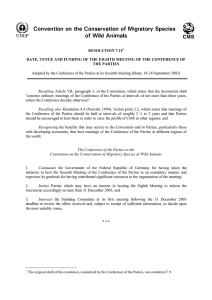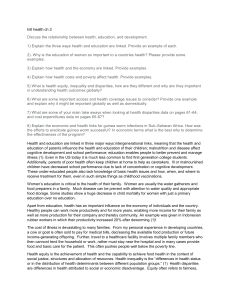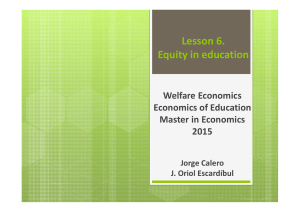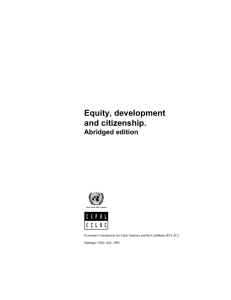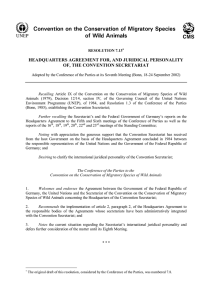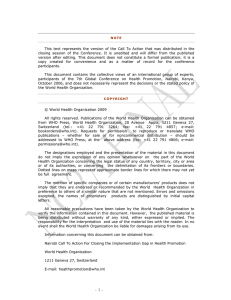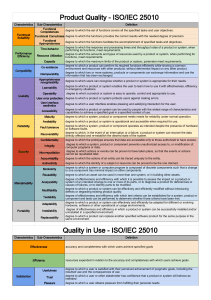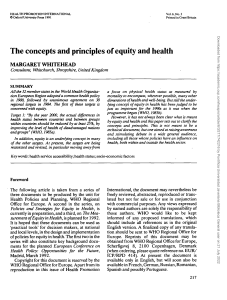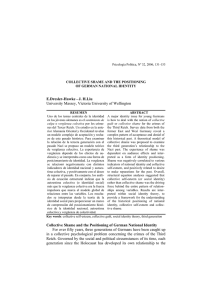Developed
Anuncio
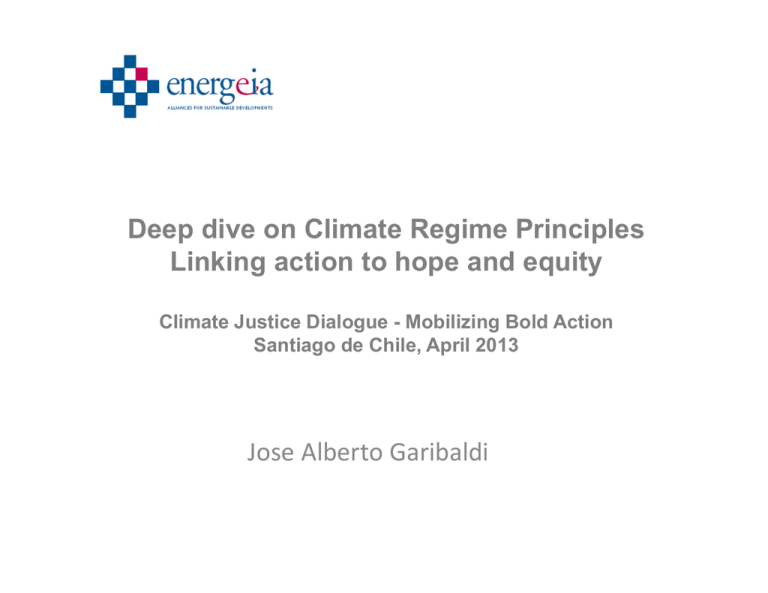
Deep dive on Climate Regime Principles Linking action to hope and equity Climate Justice Dialogue - Mobilizing Bold Action Santiago de Chile, April 2013 Jose Alberto Garibaldi Some Initial observations on the UNFCCC as an institution • The Climate institutions are set of rules – emerging from interactions by agents • These take place within a multilateral regime, encompassing in principle all parties • Agents’ play games – these: – shape rules – interpret principles • Agents choose actions within domestic and international circumstances – context counts. The context of the problem Late 1990s – early 2000s World Politics & Economics Developed countries decisively lead global economy Clear division with developing countries US/EU tension Research & Knowledge Group dynamics Division between A1 & NA!; groups within these with little internal differentiation, larger countries leading positions within groups. Arguments over CC certainty; Research focused on action by developed countries and co-benefits Negotiation dynamics A zero sum game; action only where cobenefits; EU pursuing G77 deal against US to enhance own reputation Interpreting the Convention1993-2007 / the KP world A1: We will act, but you people must do something: NA1: That´s your problem; not ours A world cut in two halves Convention (UNFCCC) ( Subsidiary bodies COP/MOP (2005) SBI The research issue: What A1 is doing and whether this is enough SBSTA Focus on KP (2005) PK (1997) A1 committed to reductions; NA1 committed to report. Firewall and CBDR central Buttressed by Brazilian proposal Interpreting the Convention 2007 – 2009 / the BAP Not our problem – but maybe we might do something Convention (UNFCCC) ( Research emphasis Shifts: Subsidiary bodies SBI AWG LCA (2007) SBSTA COP/MO P AWG – PK (2007) BAP maintains the firewall… Differentiated instances to facilitate further action by developing country parties. Sharing the burden of mitigation. BASIC project Emergence of Stern / IPCC Small number of key players Interpreting the Convention 2009- 10 / Cancun agreements We will all have equal compromises… but a diversity of actions What each one does will be measured. Convencion Subsidiary Bodies SBSTA SBI AWG – LCA Shared vision 1bii en desaroll o 1bi (Bali) – develope Bianual reports (IAR) Level of ambitio n (paragra phs 36 – 38 cancun) Bianual Update Reports PC Mitigation REDD 1biii Registrie s (ICA) Adaptation Sectoral Aproximations ibiv Diversity (para. 48 – 51) Legal form Financing Technologies AWG – KP Various Approache s(markets & Non Markets) 1bv Consecuenci as economicas y sociales de las medidas de respuesta (1bvi) Cancun creates a structure to accommodate “goals and commitments” and “diversity of actions” • • COP/MO P Instruments to support and measure both – on both sides. In exchange for new bodies on finance and adaptation Number s Mechanism os LULUCF PC Basket of metodologias • Diversity of actions will be supported • Differentiation enhanced • More new players – not only large parties Interpretation the Convention 2011-12 / Durban – Doha We will be in this all together... Convention (UNFCCC) ( Subsidiary bodies SBI AWG LCA AWG ADP SBSTA COP/ MOP AWG PK A (regime) applicable to all Equitable Access to sustainable development is raised as a principle Durban creates a platform for a new 2020 regime What does this imply? With a binding agreement applicable to all… And with immediate actions (2015), & post 2020 Equity views Larger Developing Country parties – Equity = Atmospheric space = right to emit – Right to emit = right to develop – Debate: how best to articulate right to emit globally: per capita, carbon budgets, intensities – Problem to solve: zero sum game in mitigation, focus on equity of effort, and differentiation in reporting • Primary role for large emitters • Secondary role for small or medium parties – Effort to present this as a common development position of all DCs • Small and medium piggyback on view of equity of larger emitters Equity views Larger Developed Country parties – Sharing that diagnosis? – Equity = key to unlock action? Large emitter focus – Willing to agree on debate around how best to articulate right to emit globally: per capita, carbon budgets, intensities – Problem to solve: symmetry, equal treatment and burden sharing • Primary role for large emitters • Secondary role for small or medium parties – Division between • domestic and international action • mitigation and adaptation Not clear where these views turn into a race to do more A sense of the vision of the rest: Why not focus on collectively avoiding impacts and creating opportunities? • • • • Convention´s ultimate objective is not CBDR or development Neither is it equity or equitable access to sustainable development It is avoiding dangerous anthropogenic interference with the climate And all parties, large or small, have a direct stake in this objective– avoiding CC impacts • From here – Expanding opportunities for mutual gains in impact avoidance through cooperation (i.e. non zero sum games opportunities) – A need for early incentives for action by all – CBDR & RC – A common interest in the BAP and Cancun institutions deployed to support action and cooperation – on both sides More action, more cooperation There are multiple different collective allocations and impacts possible... • Commitments for action lead and expanded global carbon market, climate finance and technology transfer • A dual institutional equilibrium in climate regime: – Cautious and shy –little if at all some contributions - diminished size for carbon market, and climate spoiled – Bold and deep – expanded contributions to carbon markets, climate might be saved • Assess collective outcomes considering all costs deriving from all parties´ stated actions • A collective focus: all parties can make a difference Not a new approach – developed by LAC parties with Energeia in 2008- 2009 within an ongoing regional workshop Are DCs better off the more ambitious the regime – for all? Assessing the world emerging in 2009 – 2010 Shy scenario ( low ambition ) Impacts 1 (climatic and socio economic) Carbon Flow 5 scenarios, with differentiated low to very high ambition: Total costs 1 + Adaptation costs •-5% and -35% (2020 & 2050) to • -35% and -95% (idem) Bold scenario ( high ambition ) Impacts 2 (climate, Socio economic) Modelling options from 2008 to 2010 offered USA, Japan, Canada, EU, Russia from 2008 to 2010 and further additional actions NA1 from: Carbon Flows Total costs 2 + Mitigation & adaptation cots Carbon markets went from having no trading at all, to having perfectly flexible, encompassing forest and all sectors •doing nothing to •–10, -15, and -20% BAU deviation (2020, 2030, and 2050) to •-35, -45, and -45% (idem) Modelling tool Stage Aspect Assessing the idea Scenarios Modelling Scenarios Compillatin of countries positions A1 – NA1 Targets and trajectories 2020, 2040, 2060 Game theory Equivalent reductions (ECOFYS) Comparability tool ECOFYS Impacts and Carbon Flows Implement. Costs Sub regional Impacts Implementation costs Regional carbon flows. Regional – Sub regional Impacts Global carbon flows and regional impacts Definition and costs of policies s (PAGE 2002, (carbon flows modeller) POLES data and PAGE PAGE 2002SR) (MAC curves) Seems to be mostly the case: Latin America – holds in all cases Forestry fungibility, expansion of trading sectors and supplementarity restrictions crucial Costs in US$ Million dollars, 2005. South East Asia -holds in all cases Idem. Impacts reduced by 6 GDP points per year; India and South Asia - holds to effort (middle) scenario Holds in low, current and effort scenarios, also in the very high one, but require bridge in finance. China and East Asia –kicks in later Holds from the current scenario and up to the medium in 2030; then again in high and very high as money gets out of forests. SE Asia Low Current Effort High V. High 2020 76207.1 75773 74167.2 72818.2 69068 S. Asia Low Current Effort High V. High 2020 2030 2040 76207.1 188263 628538.5 75599.6 179938 594657.8 74951.3 175741 499479.7 78758.3 178095 500932.8 87696.9 195976 454623.9 China Low Current Effort High V. High 2020 241.67 2030 2040 188263 628539 181467 599709 174509 544640 170290 529927 169810 472868 2030 2050 736.84 4124.81 -531.83 -14795.07 -14449.7 592.96 -7888.12 -125709.6 10522.21 6811.2 -65194.56 10505.86 6698.12 -66182.47 Consequences on research • Problem misdiagnosed: for a majority, major costs are impacts not mitigation • Equity - focus on avoiding impacts, convention objectives • Emphasis on allocation and access to a transformative development – not on emitting more • Based on bold and differentiated action by all • Considering circumstances: – Smaller parties cannot support impacts, larger parties can. – Larger parties need to reduce, smaller parties need avoid increase • Not trade paradigm - what is needed now is not what will be needed tomorrow • Dynamism and flexibility to accommodate all Consequences on principles • • • • • • • Action important on its own - not only linked to equity Hope and responsibility central - not only justice Equity = equity of outcomes / intergenerational /Across groups Development = transformative development CBDR = CBDR&RC – a prompt for action National circumstances = opportunity, not an excuse. Importance of the morality and leadership of the own example as an collective action prompt – regardless of size • All parties relevant – particularly those suffering and willing to act Debate: how about finding collective allocation solutions were we all contribute and cooperate to do more…soon? All this possible within existing convention principles: Consequences on negotiations • Emphasize collective focus on need to avoid impacts • Walk the talk: press more larger emitters with own example – wherever they are grouped • Trade resulting mitigation action and regime advances for: – further collective support – incentives for enhanced leadership by early and ambitious movers – big, small or tiny • Align and press for carbon markets and finance for enhanced action: a solution cannot be achieved if both are constrained • Time is of the essence: structure negotiations so all areas can advance, diminish blockage potential • Support and learn from other parties or groups, large or small, willing to stand up and do the same. What has this group of countries done? More things that I can count, but will focus on those we have supported from Energeia EOB – an analysis around parties´ actions and an interpretation around UNFCCC principles Since 2009 Workshop to increase the scale of responses (meeting 11 times since 2006: with at least an equal number of collective submissions Interregional workshops – across G77 groups (in Punta Cana & Bali) Supported each others´ negotiators since Bali - not to lose capacity What this approach has deployed – by 2013 World Politics & Economics Using enhanced domestic economic stability and growth to underline visibility of own actions, raise further action and finance, and help address severe impacts Research & Knowledge Group dynamics Taking advantage of resulting differentiation, enhanced leadership by smaller groups, multiple coalition creation Integrated research focused on interaction of collective, mitigation, adaptation and impact costs Negotiation dynamics Advance positions that focus on action, compromise and cooperation –and on reducing impacts and expanding opportunities Could this make it? The chances of a virtuous cycle at scale MICs could contribute a substantial scale of emission reductions – between 0.7 to 1.2 G, from countries emitting less than 0.5 Gtons in SEA, LAC, AOSIS and parts of Africa are considered. not that far from China proposed reductions (1.3 Gtns). Not that far from those committed by the US. • • • • This approach is internally consistent: it practices what it preaches and is part of the solution, not the problem Takes the principles of the convention on its literal meaning Focus on areas where cooperation is possible, making the most of their circumstances Does not separate domestic and international interests A virtuous cycle at scale: enhances chances of forming larger coalitions encompassing larger emitting parties and gradually but promptly move to to trajectories between 1.5 and 2 degrees. Reduces costs of required mitigation targets by A1 parties would be diminished (compared to the alternative, where these regime mechanisms were not present). Reduces major costs of developing countries - impacts
